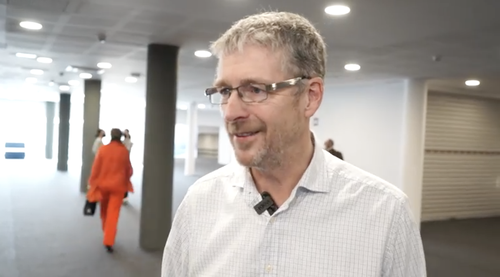6G won't be a brand new radio normal, say BT and Vodafone
No one actually is aware of what 6G shall be, or even when the generational strategy will nonetheless be in use eight years from now, when it might be anticipated to reach. Probably the most far-fetched concepts contain brain-computer interfaces, permitting individuals to manage machines by thought. Probably the most humdrum envisage extra energy-efficient base stations and open interfaces. However, two outstanding telco executives suppose they already know what it won't be, – and that is a brand new air interface.
Andrea Dona, the chief community officer of Vodafone UK, and Howard Watson, the chief expertise officer of BT, are more and more assured 6G will use the identical orthogonal frequency division multiplexing (OFDM) expertise on which 5G relies. It's an important growth just because a lot of the analysis for earlier generations was centered on the air interface.

BT's Howard Watson: 'I really like the actual fact it is the identical radio normal.'
(Supply: Mild Studying)
“6G shouldn't be going to have a brand-new connectivity layer,” mentioned Dona at a press convention this week. “It is not going to as a result of there's nothing popping out of universities when it comes to new entry methodology. It's nonetheless going to be OFDM applied sciences, the identical applied sciences I studied 20 or 30 years in the past on the College of Padua.”
His remarks got here days after Watson delivered the identical message at the latest Cell World Congress (MWC) trade show in Barcelona. "I really like the actual fact it is the identical radio normal," he informed Mild Studying. "Thus far it is trying like that is the identical."
Competing concepts
If they're proper, the Worldwide Telecommunications Union (ITU) arguably faces an excellent larger problem than regular. Earlier than the tip of the 12 months, the United Nations physique is anticipated to stipulate its imaginative and prescient for 6G, setting the parameters that worldwide requirements teams will subsequently observe, in keeping with Adrian Scrape, the chief expertise officer of the European Telecommunications Requirements Institute.
When it printed its 5G imaginative and prescient in 2015, the ITU devoted a lot of its consideration to radio, as proven by the essential press launch it issued on the time. "The subsequent step is to ascertain detailed technical efficiency necessities for the radio methods to assist 5G, bearing in mind the wants of a large portfolio of future situations and use circumstances, after which to specify the analysis standards for evaluation of candidate radio interface applied sciences to affix the IMT-2020 household," it mentioned. IMT-2020, basically, is the ITU's code word for 5G.
But when this half stays the identical in 6G, telecom authorities might want to give you one thing that warrants trade and authorities consideration. And right here, there are actually dozens of competing concepts, – lots of which look tangential to telecom.
Dona thinks 6G must take into account future wants extra significantly than 5G ever did. "You must shift away from a technology-based answer to a extra service-based answer, and that's the basis of 6G," he mentioned. "You might be getting to some extent of plateau when it comes to connectivity, and it's essential to have a look at the companies {that a} mixture of assorted applied sciences can ship." Networks shall be way more software-based than at the moment's, he reckons.
But regardless of his confidence that the air interface won't change, Watson hopes 6G will assist the introduction of upper spectrum bands and the rollout of further websites. “I feel what brings 6G to life is millimeter wave and high-scale identification," he mentioned. "We do not have the workloads for that now when it comes to shopper or enterprise demand, however by the tip of the last decade we'll be there."
Analysis is already underway into the usage of a lot higher-frequency Terahertz spectrum, the place the disadvantage is the brief distance {that a} cellular sign would journey. “If we will get that to work, then entry to giant quantities of spectrum might be not going to be an excessive amount of an issue," mentioned Scrape. "How we harness it and make environment friendly use of it might be more difficult. We're solely speaking just a few tens of meters of propagation, however for a lot of those purposes we're solely that type of distance and positively not wide-area networks."
For AT&T and Nokia, there appears to be higher curiosity in enhancing the uplink functionality of cellular communications by a system often called distributed MIMO. "If I can get to the purpose the place the system can discuss to many radios on the identical time, then that provides a definite profit on the uplink, and that is the place we're centered now on proving a few of these capabilities," mentioned Gordon Mansfield, AT&T's vp of converged entry and system expertise, throughout an interview at MWC. Sooner uplink speeds, in fact, might be crucial in a world of extended-reality purposes.
However, not everybody could also be prepared to simply accept OFDM as a part of 6G without query. Cohere Applied sciences, a software program startup with a expertise that would enhance community capability, is now pushing a modulation scheme known as orthogonal time frequency and area (OTFS) as a possible 6G candidate.
"We spent a superb little bit of time creating an answer that included this new waveform," mentioned Ray Dolan, cohere's CEO, at MWC. 6G and even late-stage 5G may embody "a collection of normal airlinks," he informed Mild Studying. The way forward for cellular continues to be up within the air.






Post a Comment
0 Comments